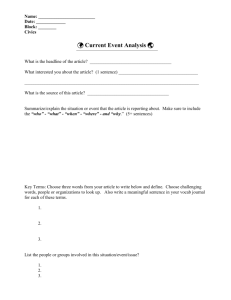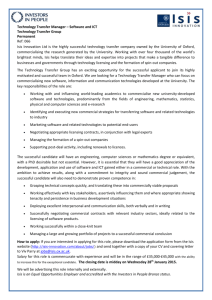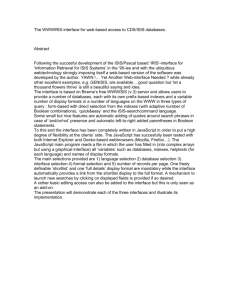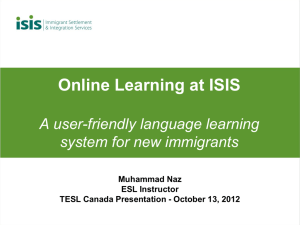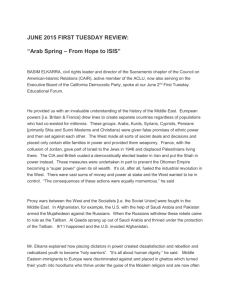ISIS: Integrated Safety Information System
advertisement
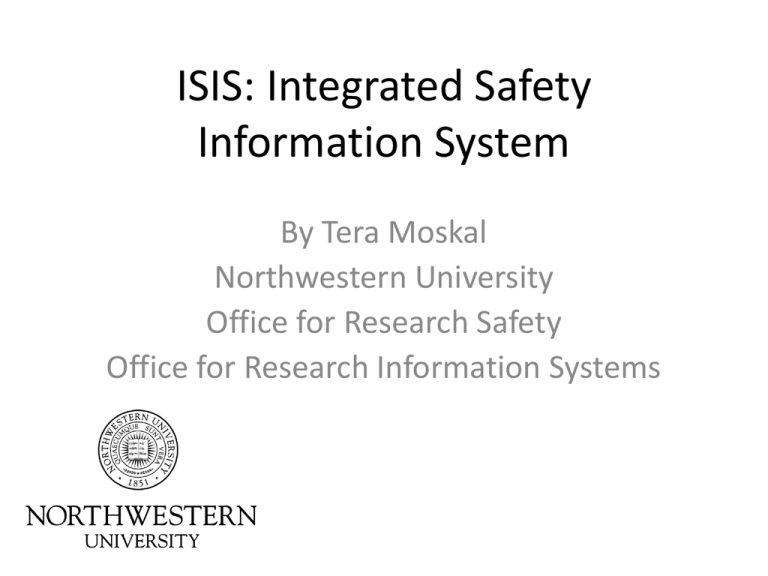
ISIS: Integrated Safety Information System By Tera Moskal Northwestern University Office for Research Safety Office for Research Information Systems Who we are and how we operate Office for Research (OR) is an umbrella group to which all other research offices report. OR Office for Research Information Office for Research Safety (ORS) Systems (ORIS) provides provides services for NU leadership in the design, creation community who may be and deployment of technical exposed to hazardous materials solutions for the research and processes. community. ORIS ORS Life at NU with outdated paper and pencil systems… and the problems we faced on a daily basis First, an explanation of an acronym that we use throughout the entire presentation PI = Principle Investigator = Researcher at the University The problems with paper Processes were paperbased, including: the Safety Plan, registrations and applications, Lab Annual Reviews, and committee reviews. The problems with paper For many processes, information was only updated annually, but lab conditions were constantly changing. The problems with paper It was hard to keep an accurate account of the hazards in the laboratories. The problems with paper With multiple forms came duplicate information being requested from the researchers. The problems with paper Researchers and lab workers tended to glance through the information without really reading it. Many, many problems Researchers had to go elsewhere for access to supplemental information. Many, many problems Updating personnel information was difficult. Many, many problems After everyone signed the forms, if something changed, it wasn’t always properly vetted. Many, many problems Laboratory inspection process was not automated. Many, many problems No easy way to collect statistics at the end of the year. Who needs statistics, anyway??? The methods we used to solve our paper problems Which led to our journey into unchartered territory Getting started… A computer system was the obvious solution. Existing software products were too generic for our safety programs. System developed in-house met the exact safety program requirements. Requirements for the system It had to be Since each PI’s The system extremely userresearch was needed to not friendly because different, only track we couldn’t requiring compliance, but possibly train the also to be used as different safety entire user an educational forms, the system community. had to be tool for the dynamic in its research structure. community. Our first year of development… Scope and purpose of the software • Create a lab safety profile. • Organize registrations and applications for regulated programs, such as radiation and rDNA. • Provide direct access through links to external resources, such as OSHA standards. • Educate PIs and lab workers on laboratory safety best practices. • For laboratory use only. Not intended for general environmental and occupational health and safety. The software collects data in the following safety and compliance programs: • Exempt select agents toxins • Work at biosafety levels 1, 2, and 3 • recombinant DNA • Compressed gases • Bloodborne pathogens • Controlled substances • Hazardous chemicals • Equipment alarms • Animal use • Hazardous materials shipping and receiving • Personal protective equipment (PPE) • Physical hazards • Laser equipment • Radioactive materials How we created our safety system • Project developed by three IT and ten Research Safety staff members. • Two years to develop core product. • Majority of time spent organizing business processes. • Used .NET technology and Oracle database. • Web interface walked users through data entry process with wizards. How we rolled the system out Soft rollout spanning one year. Users requiring new registrations or renewals of existing registrations allowed to start early. Small groups brought online each month. Cohorts based on annual laboratory inspection dates. The results User profile screen Each user must select the profile that they wish to maintain during the duration of the session. Based on the profile they select, ISIS allows different functions to be performed for the same user. The first time a PI logs into ISIS, the system collects information on: • • • • • • • PI demographics Emergency contacts Lab building and room numbers Lab worker demographics Abstract of research goals Procedures used in research Thirteen questions about research For PIs who are too busy to enter their information, they can assign a safety designate. PI demographic screen PI demographic information is kept up to date in ISIS. The system keeps track of mailing addresses, emergency phone numbers, and department affiliation. Laboratory information screen All labs associated with the PI must be entered into ISIS. More than one PI can be associated to a single room, such as in the case of open-bay labs. Laboratory worker screen All lab workers for each PI are entered into ISIS. It is the PI’s responsibility to keep the list of their workers up to date. The list is audited for accuracy during the laboratory annual inspection. Research goals screen The PI or their safety designate enters a short description of their research goals. PI procedures and equipment screen On this screen, the PI or safety designate indicates which procedures and equipment are used in their research. The core of the software • ISIS is presented in a “wizard” format, which walks the user through the data entry process. • Researcher answers thirteen basic questions. • ISIS determines which forms are needed. • All data must be kept current in ISIS for compliance, including regulated registrations and applications. With ISIS, unnecessary forms are a thing of the past! Beginning the evaluation wizard The user is led through a series of questions. There are also links to supplemental material. ISIS guides user to the Safety Forms Menu • Becomes main screen for PI. • Access to required safety forms. •Can submit registrations and applications from this page. •Upon completion of basic information, menu bar at top grows to include all available functions. Hazardous chemicals wizard screen A user is presented with this wizard only if they have answered “yes” to the hazardous chemicals question. The material presented on this screen is designed to be educational, with links to outside resources. Lab workers enter their demographic information and review PI material Lab Worker main screen Lab workers can review all of the safety forms pertaining to their PI from this menu. The role of Administrator has special privileges in ISIS Administrator capabilities • • • • • Search on any user (PI or lab worker). Bring up detailed information about a PI. Print several different reports for statistics. Create a lab annual review. Change basic questions, links to external information, and lab annual review questions. • Review registrations and applications. Search for PI screen Administrators can search for a PI to display complete details about that person. PI detail screen From this screen, administrators are able to see the complete picture of a PI’s research. PI detail screen enlarged Enlarged PI detail screen continued Laboratory detail screen Laboratory Annual Review main screen PIs are required to have all labs inspected annually. From this screen an Administrator can create a new review, edit a current one, or review previous inspection reports. Laboratory Annual Review sections From the tablet, the Lab Safety Specialist fills out the different sections of the Laboratory Annual Review form. The form can be tailored to fit the laboratory environment by adding sections of the form if needed. Laboratory Annual Review screen This form is used at the beginning of the lab inspection process. Laboratory Annual Review screen - enlarged view The Laboratory Annual Review is the auditing mechanism for ISIS data A Lab Safety Specialist (LSS) reviews the data the PI entered into ISIS. Follow-up procedures in place to ensure PI addresses LSS’s comments. If ISIS data is inaccurate, PI must go back into ISIS and update to reflect lab conditions. LSS downloads the latest PI data onto their tablet PC, and prints out relevant reports. LSS goes and inspects laboratories. Report filter screen Administrators can choose different reports to view or print. New reports can be easily created from the stored data, if needed. Sample report in .pdf format Some important concepts we incorporated into the design All safety forms followed a wizard format. Kept the wizards in the same question order and wording as the original paper forms. Wanted to make the user experience as familiar as possible. Provided educational resources through links. Forms and questions change frequently, making a dynamic system necessary. Where are we now? • Phase 1 rollout was completed in February 2008. • All cohorts were brought online. • The ISIS project has moved into Phase II of development. • Phase II development will conclude by October 2008. Phase II development includes Laboratory closeout procedure. Annual laboratory inspection process. Revisions to the recombinant DNA wizard. Future phases of ISIS. Electronic submission and review for rDNA and radiation. Prototype of electronic review process Conclusions • Phase I rolled out on time. • Software was virtually free of bugs. • Generally well accepted in the research community. • Improved the overall level of safety and compliance. • Provided comprehensive reports and metrics that informed management. • Documented compliance with various regulations. Things we learned along the way… Engage the stakeholders early. Have your business processes well defined. Leverage regulatory programs for greater overall compliance. Once you have the data, you can no longer claim ignorance. Over three years, we learned a lot! Gradual rollout was a more manageable way to introduce the product. Give researchers individual attention if needed. Wizard format reduced confusion. Keep the question sequence and wording similar to original paper forms. We still have a lot of paper files, but we are steadily gaining ground! Technical take-aways • Make everything as dynamic as possible. • You can’t count on everyone using the same technology, so plan for that. • XML is a wonderful technology when you can’t rely on wireless access. • To develop a large application with a minimal staff, start small and keep adding to it. • Help the safety people to think in technical terms. Show them the possibilities through prototypes. ISIS contact information Todd Leasia Director Office for Research Safety ltl419@northwestern.edu Dan Volocyk Director Office for Research Information Systems d-volocyk@northwestern.edu Tera Moskal ISIS Project Manager Office for Research Information Systems t-moskal@northwestern.edu Suresh Mallipeddi Lead Developer Office for Research Information Systems s-mallipeddi@northwestern.edu
